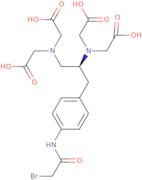(S)-1-(p-Bromoacetamidobenzyl)ethylenediaminetetraacetic acid
CAS: 81677-64-7
Ref. 3D-FB19182
| 2mg | Descatalogado | ||
| 5mg | Descatalogado | ||
| 10mg | Descatalogado | ||
| 25mg | Descatalogado | ||
| 50mg | Descatalogado |
Información del producto
- N,N'-[(1S)-1-[[4-[(Bromoacetyl)amino]phenyl]methyl]-1,2-ethanediyl]bis[N-(carboxymethyl)-glycineBABE
- Glycine, N,N′-[(1S)-1-[[4-[(bromoacetyl)amino]phenyl]methyl]-1,2-ethanediyl]bis[N-(carboxymethyl)-
- N,N′-[(1S)-1-[[4-[(2-Bromoacetyl)amino]phenyl]methyl]-1,2-ethanediyl]bis[N-(carboxymethyl)glycine]
- BABE
- Glycine, N,N′-[1-[[4-[(bromoacetyl)amino]phenyl]methyl]-1,2-ethanediyl]bis[N-(carboxymethyl)-, (S)-
- Glycine, N,N′-[(1S)-1-[[4-[(2-bromoacetyl)amino]phenyl]methyl]-1,2-ethanediyl]bis[N-(carboxymethyl)-
(S)-1-(p-Bromoacetamidobenzyl)ethylenediaminetetraacetic acid (BABB) is a DNA transcription activator that is used in the treatment of wastewater. It activates transcription by binding to regulatory proteins and polymerase chain reaction (PCR). The activated form of BABB can be detected using an assay on a carboxy terminal protein. This drug has been found to be effective in treating patients with cancer, as it inhibits the synthesis of DNA and RNA. BABB also has diagnostic properties because it binds to monoclonal antibodies and α subunit sequences.





